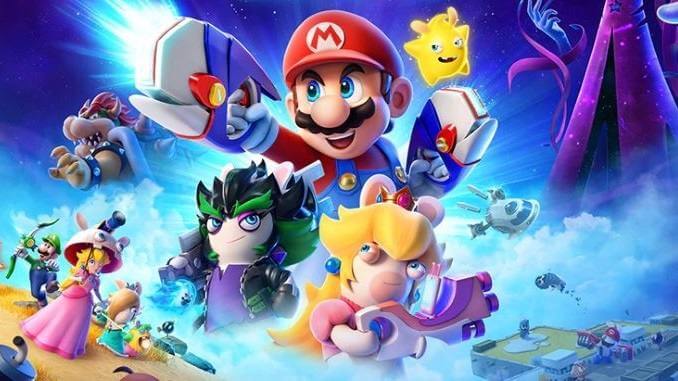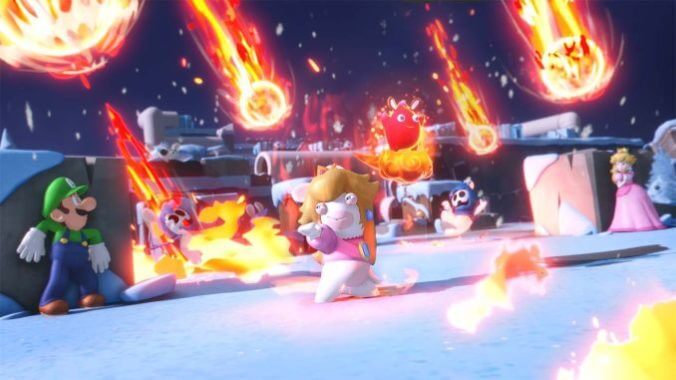Mario + Rabbids Sparks of Hope Is Off the Grid and Out of This World

Tactics, strategy and underlying subgenres often feel hellbent on appealing to the hardest of hardcore audiences. Bleak, dystopian worlds subjugated by alien invaders with equally unwelcoming mechanics and gameplay are considered the cream of the crop. And rightfully so; the XCOM games are fantastic. Unfortunately, legions of games chasing that same ethos don’t always bring the same brilliance to the cause, and thus the genre tends to bleed together and alienate the average player in the process.
Recent years have seen that status quo defied from multiple angles. Into the Breach delivers the best game in the genre by trimming nearly every ounce of fluff from other tactics greats, Triangle Strategy offers a gorgeous revival of the classic tactical JRPG, and Gears Tactics broke free from the grid and injected some immensely satisfying ideas into the genre. Still, none have done what Mario + Rabbids: Kingdom Battle did in 2017: make tactics approachable.
That’s not to say others haven’t tried and succeeded in the past, but the first Mario + Rabbids felt like a turning point in the genre. Since its inception—which was met with critical and fan acclaim—the tactics genre has expanded. Not because Rabbids influenced other greats that came after it, but because in the five years and change since its release, we’ve seen a boom in tactics games. From new takes on classic franchises like Gears Tactics or the upcoming Metal Slug Tactics, to the emergence of smaller experiences like Into the Breach, to returning classics like Tactics Ogre and Advance Wars, the landscape feels different than it did just five short years ago.
Now that we’ve seen this groundswell, Rabbids has much more to reckon with. Luckily, Sparks of Hope lives up to the first game’s legacy in shaking up and reorganizing the very notion of not just the turn-based strategy game, but the first Mario Rabbids game. Mario Rabbids Sparks of Hope is a tactical playground rife with charm whose dazzling score (penned by some of gaming’s greatest composers), measured doses of fanservice, and deeply satisfying (if occasionally shallow) gameplay delight far more often than they have any right to.
Mario + Rabbids Sparks of Hope is a bizarre game. Not necessarily because it’s a crossover between Mario and the Rabbids, but because it bears the trappings of an Ubisoft game and a Nintendo game at the same time. For me, these are dissonant things. Ubisoft’s horrifying business and creative practices, only to be outdone by its workplace culture, aren’t what I’m talking about, either. After all, not even squeaky-clean Nintendo’s above mistreating its employees.
I mean that each major area in Sparks of Hope is an open world, with generic piles of goo to clear away via tactical battles. The worlds surrounding them are distinct and fun enough to be in that they don’t blend together nearly as much as the standard Ubisoft game, but being plopped into an open area full of things to do is overwhelming at first. Luckily, the worlds are small and easy to mainline, so Ubisoft’s trademark bloat is largely nonexistent.
Unfortunately, the structure’s the only Ubisoft trademark that’s missing. Its difficulty options, which offer a few individual selections that allow the player to customize their playing experience are paltry. I played a decent chunk of the game on its hardest difficulty until I realized that the only changes that came with the hard mode involved enemy health and damage. Enemy AI seems to always be the same difficulty, so playing on hard mode effectively just makes every enemy tankier. That’s not the kind of challenge that actually adds anything to the game most of the time and takes away from its overall pacing.
Sparks of Hope is a big game, so it only makes sense that it launches with some bugs at launch, but I can count on more than one hand the number of times I’ve had to restart a battle because I did something that the game wasn’t prepared for. Now I’m pretty savvy when it comes to tactics games, but I’m not that good. The most frustrating instance of this was the fact that I had to restart the gargantuan, three-phase final boss fight twice. It even seems to have some system-level bugs, as it inexplicably altered my Switch’s resolution, causing it to output in 480p, despite being docked and set to 1080p. This happened after leaving the game in sleep mode while playing it handheld on the bus and then docking it.

I’m not a programmer or hardware engineer, but I’ve never had this issue with my Switch aside from when reviewing Sparks of Hope, so I’m reasonably sure that it’s a problem with the game’s native resolution in handheld mode, but I couldn’t say with absolute certainty. However, this does point to the only other real issue with Sparks of Hope: it’s a Switch game. I love the Switch; it’s my favorite piece of gaming hardware, probably ever. I’ve traveled the world with it and played most of my favorite games of all-time on it, including ports like Wolfenstein II, which ran at 30 FPS. I bring this up to make it clear that I have no problem with pared-down experiences as long as they run well and feel good to play on the Switch.
Unfortunately, that can’t always be said of Sparks of Hope. It’s either too much game for the Switch, or it’s poorly optimized. Of course, there’s almost certainly something that I’m missing, but my point stands; the Switch can barely handle this game. Objects and textures pop in during cutscenes and the game throws loading screen after loading screen at you; cycling between menus and battlefield overviews before a battle, entering a battle and even opening the overworld map all present you with a loading screen. It’s rarely an egregiously long loading screen, but it adds up, especially when you’re constantly switching between the battlefield and your menu to get the perfect team and configuration set for each challenge.
-

-

-

-

-

-

-

-

-

-

-

-

-

-

-

-

-

-

-

-

-

-

-

-

-

-

-

-

-

-

-

-

-

-

-

-

-

-

-

-








































